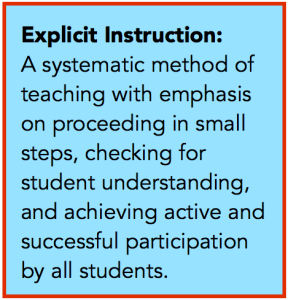
Research
indicates that explicit instruction is a highly effective teaching strategy,
particularly when students need to acquire new knowledge or skills. We use explicit instruction as the
pedagogical model through which all new content is taught. Explicit instruction is where the teacher
explicitly conveys to the student the purpose, process and expected outcomes of
any task or assessment.
Successful sports people, musicians and artists listen carefully when
their coaches or mentors are particularly explicit in their instructions. As teachers, we can take on the ‘coaches’
mindset of being determined to make our students perform at their brilliant
best as explicit as possible.
Although the
following stages must be done in the sequence below, teachers may not
necessarily follow every step every time.
An initial lesson, for example, may just contain the Lesson Introduction
and I Do. The following lesson may do
this again adding the We Do. At times,
some lessons require moving back and forth between the I Do and We Do several
times before moving onto the You Do.
Teachers are tasked with making these pedagogical decisions based on the
content, their experience, and their students’ understanding.
Critical elements of explicit instruction
- Optimal use
of instructional time - Students engaged and on task at all times
- High levels
of success at all stages
- Focused on
critical content matched to students’ instructional needs
- Sequenced
logically - Breakdown complex skills and strategies into smaller steps
- Supported
practice
- Timely
feedback – immediate and affirmative
Source -
Archer, A. & Hughes, C. Explicit Instruction – Effective and Explicit
Teaching, (2011), Guildford Publications